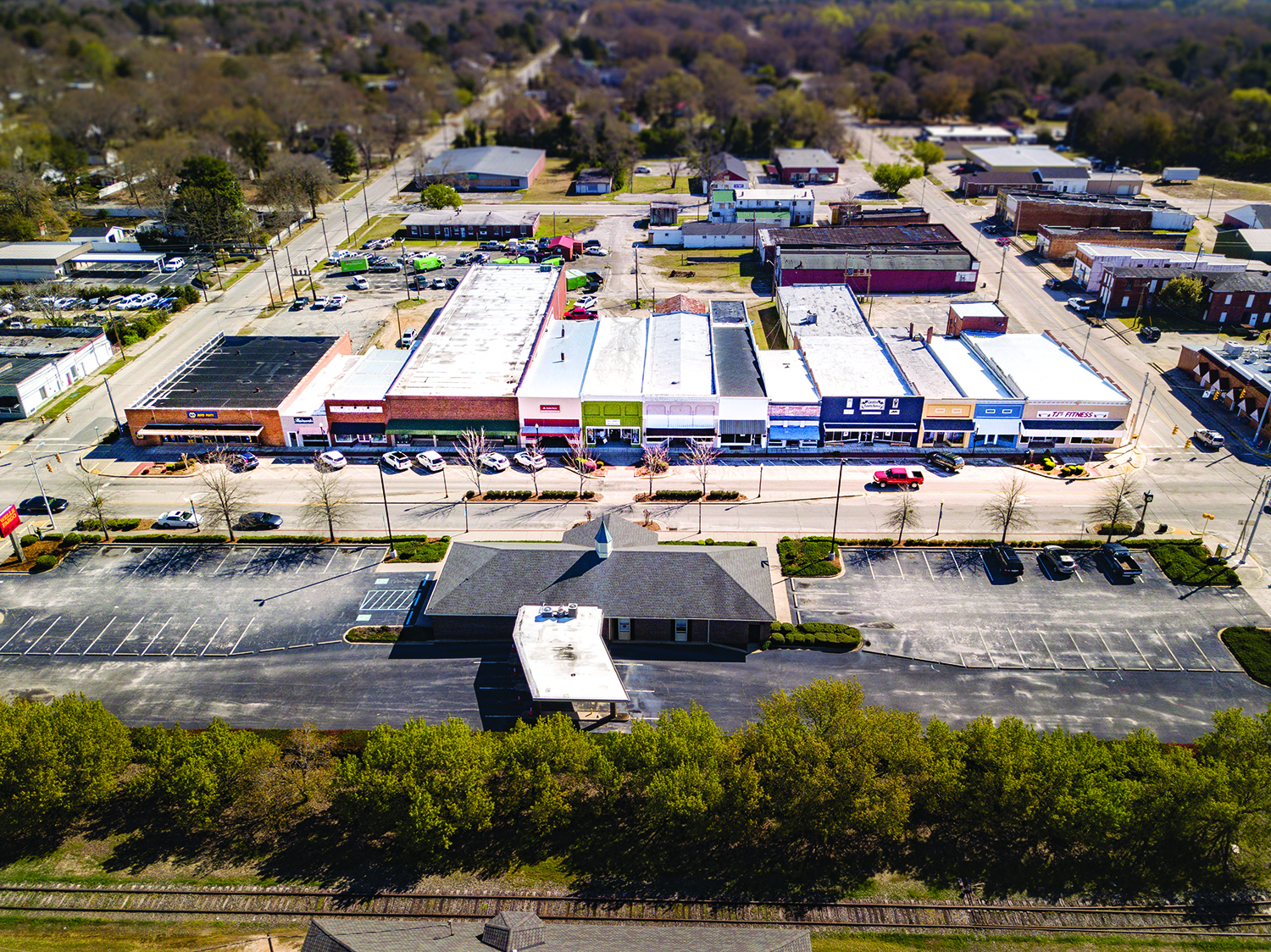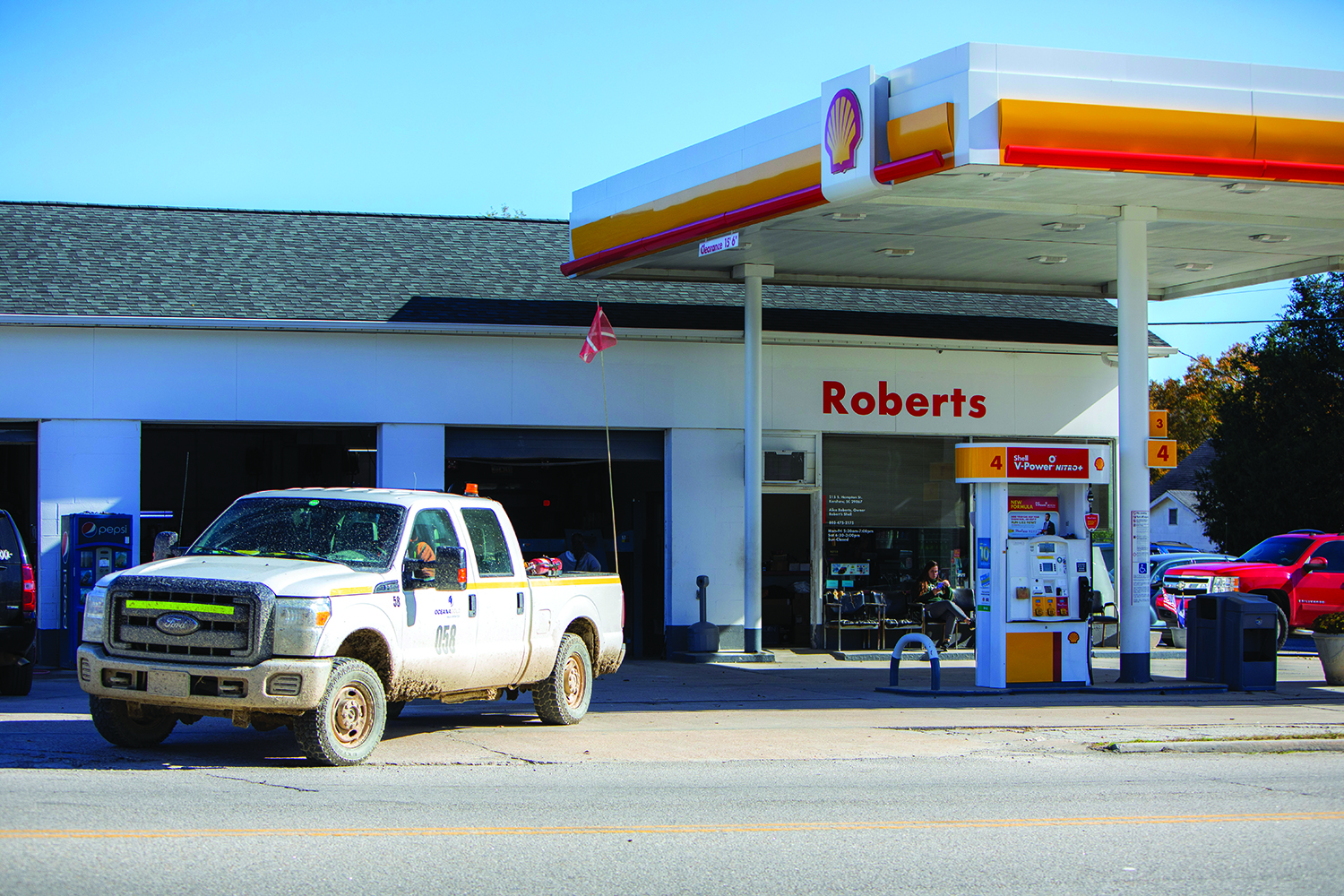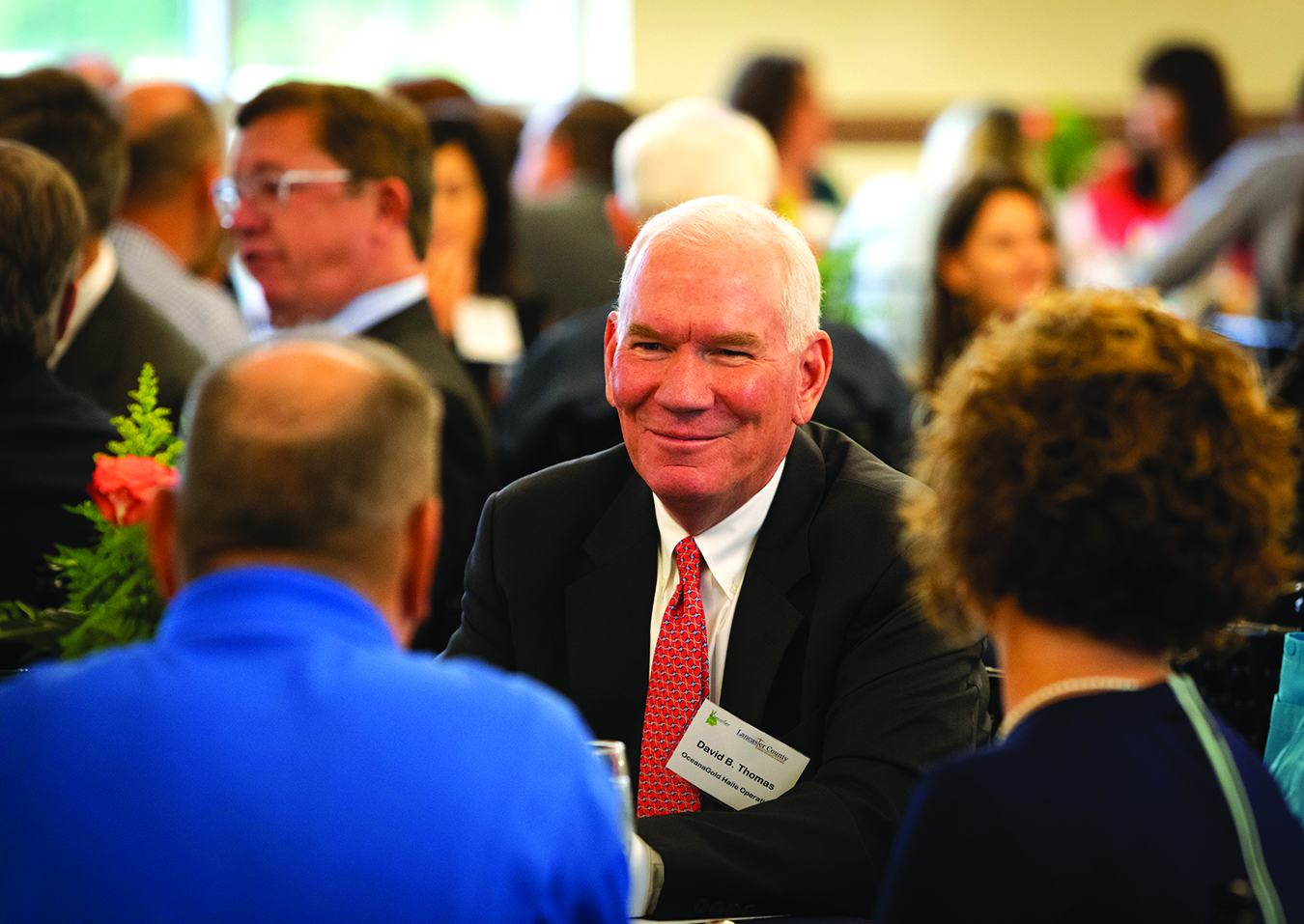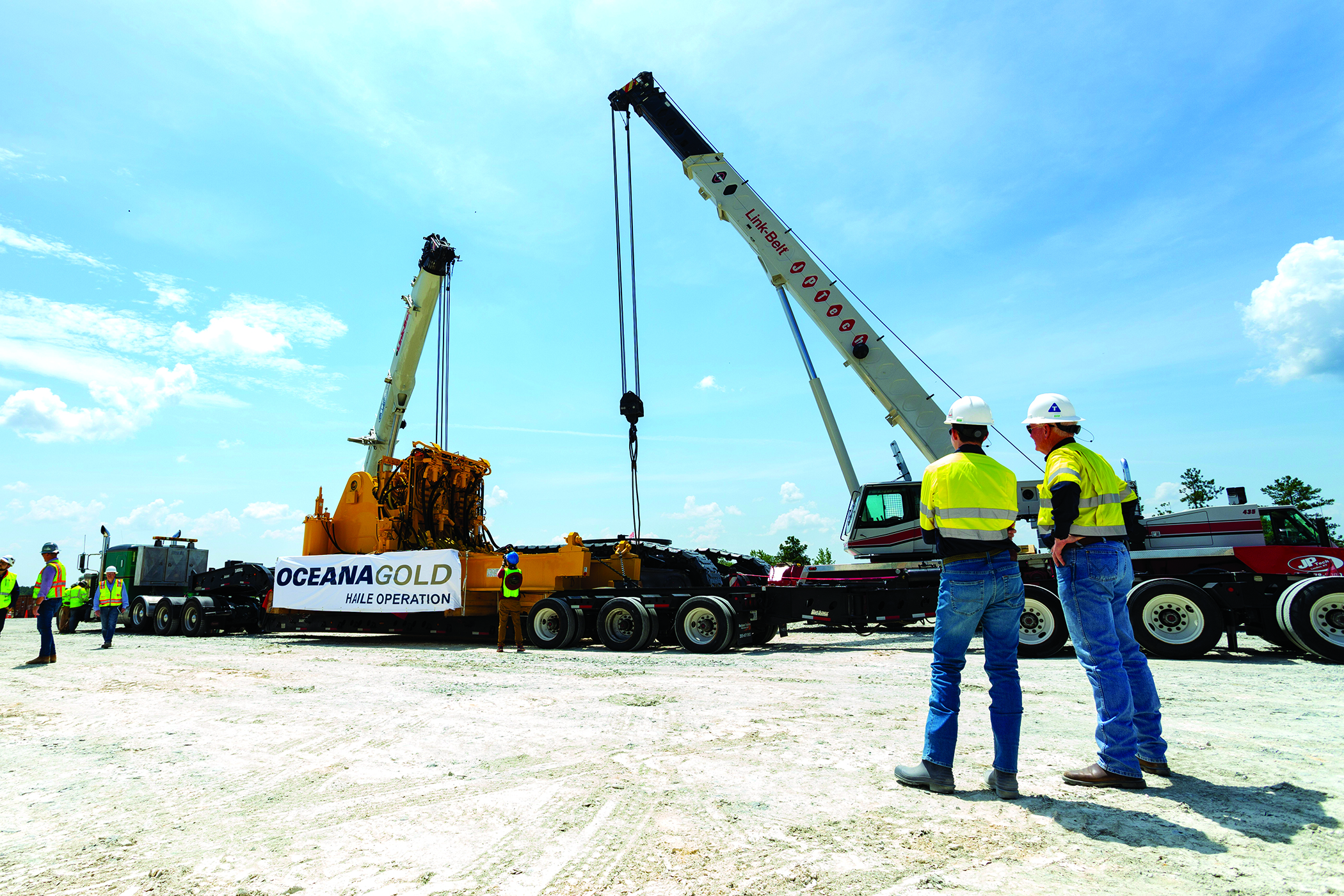 How OceanaGold defied the odds, won over an insular small town, and did the impossible
How OceanaGold defied the odds, won over an insular small town, and did the impossible
By Jesse Morton, Technical Writer
In Dixie, a small town is measured by the number of churches, stoplights and gas stations it has. Sited amid the cotton and corn fields, the deciduous forests and rolling hillsides that separate the foothills of Appalachia from the Lowcountry, Kershaw, South Carolina, the hamlet a couple of clicks from OceanaGold’s flagship American gold mine, Haile, has three gas stations and almost three dozen churches.
Some of the houses in the area are certified historical landmarks, with Antebellum architecture and massive oak trees. Others, more distant from town, look like they are being swallowed by the landscape and point to a different and more difficult history.
Some of the roughly 2,000 residents of Kershaw will tell you they have had family in the area since the Revolution. In a museum by the tracks in the center of town, a table once used by George Washington abuts a wall adorned with framed yellowed pictures of miners long gone.
Mining has intermittently been a source of income for some families within the community going back more than a century, and many of the residents of the area have the pictures, antiques, keepsakes and family lore to prove it. In the late 1890s and early 1900s, E&MJ reported that Haile, named after the man who brought the mine into commercial production, was the biggest gold mine east of the Mississippi, and it proved large-scale gold mining was still economically viable on the Carolina Superterrane.
So it may seem not at all odd that a multinational mining corporation was able to move in, swiftly navigate the permitting process, break ground, and speedily ramp up to producing more than 100,000 ounces per year (oz/y).
Yet Kershaw is also a part of metamodern, post-industrial, environmentally conscious America. And so it is odd in a way, considering the seemingly universal difficulty miners have today launching new mines in the U.S.
Within the last year alone, miners in Arizona, Minnesota, Michigan, Idaho and Alaska have had longtime plans for new mines stalled as tribes and mining opponents sue and courts overturn permits. Plans for a Minnesota iron ore mine located in an area renowned for its support of mining may see permits that took years to acquire nixed by the courts and the legal actions of fellow Minnesotans. A proposed new Idaho gold mine in a remote mining district home to literally dozens of century-old mine sites faces delays as local tribes sue over water issues that date back decades.
In both cases, the miners had both history and the local culture on their side. And at this point, neither will meet with early phase success remotely similar to that of Haile.
Insiders say that success can be attributed to three things. The first is a rare confluence of factors, an advantageous alignment of events, that put the miner in the exact right place at the exact right time. The second is the three-pronged approach to community relations administered by David Thomas, vice president and country director, OceanaGold, Haile Operation. The third, according to the Kershaw town administrator, Mitch Lucas, is the miner’s retention of critical, game-changing talent, namely David Thomas.
An Advantageous Alignment of Events
Mitch Lucas describes himself as a retiree wannabe. He told E&MJ that his government position was supposed to be a hobby job and wasn’t expected to be as time and energy consuming as it has become. It now requires just under 40 hours per week, and that, like much else that is happening in Kershaw these days, is a result of the mine.
When Mitch got into local politics, the town was in decline. In the mid-1990s, Springs Industry, a specialty fabrics manufacturer with two dozen plants in South Carolina, sold its Kershaw site and dismissed roughly 1,000 employees. “When that closed, this town almost died,” Lucas said.
Around that time, the town did what many others in that type of situation have tried. It lobbied for and won a prison. Kershaw Correctional Institution opened in 1997, bringing some jobs and otherwise mixed economic tidings. “If Kershaw hadn’t had a prison, we really would have closed down,” Lucas said.
Aside from the prison, there was a soybean plant in the county. The two provided the town a lifeline. Lucas said it amounted to a drip feed. Unemployment remained high. Almost a quarter of the town’s working age adults were jobless. Empty homes and properties overgrown with weeds and kudzu became commonplace. The town needed a break.
And so did gold miners.
Throughout the period, gold prices dropped. They hit rock bottom around the millennium and then started to tick skyward. In late 2005, they hit $500/oz. The old mine up the road, which more recently had been acquired by Piedmont, had seen action on and off over the past century, but hadn’t been mined on a large scale since 1908.
In 2006, Romarco started discussions with the local government. “First and foremost, they said they would look out for the environmental aspect of Kershaw,” Lucas said. In 2007, Romarco bought the mine.
The timing was impeccable. By 2008, the market conditions were near perfect.
Stocks were crashing and investors were fleeing into precious metals. The Federal Reserve was printing money and buying bad stock bets, creating price inflation. Gold was soaring.
And housing prices, meanwhile, were plummeting. The lands surrounding the historical Haile mine were all privately owned. It was the perfect time to buy.
Between 2008 and 2011, Romarco got into real estate. Ultimately, more than 150 residents would be relocated, with most of them moving into the town proper. “That brought a big boom to the population,” Lucas said. “Prior to that, there were more than 60 houses vacant in town and the surrounding area, and now there are less than 10 vacant.”
In 2015, OceanaGold bought Romarco. With the launch of the construction phase, motels filled up. Restaurants, retailers, and the town’s oldest gas station, Roberts Shell Station, described as the last full-service station in the South, did brisk business. “The bank balance of the town of Kershaw is in good shape,” Lucas said. “Schools are definitely in good shape.” The local economy is in such good shape, in fact, that the town recently voted in favor of a bond referendum that would raise taxes.
With the growth, the town needed infrastructure upgrades. For an emergency water supply to the mine, the state of South Carolina forked over roughly $1 million. OceanaGold dropped $1.2 million on it. “We now have a 12-in. water line that connects to our water service department, and they built a new tank,” Lucas said. “We now have the capacity to supply the emergency needs of both the town and the mine.”
The town now plans to upgrade its sewer system by 2021. The main line will go from 8 in. to 12 in.
The town is working with Duke Energy to have more electricity run to the area to support a planned office park.
But the biggest economic contribution the mine has made is to employment. OceanaGold employs more than 450 at the mine. Additionally, more than 150 contractor employees work there.
 Those personnel live and spend money in town. Almost 85% live within a 50-mile radius of the mine. The mine buys fuel from the Roberts Shell Station. The miner co-sponsors local festivals and parades that bring in weekenders and tourists. The boon in tax money has allowed the municipality to open three parks since 2007, bringing the total to five. “That is a lot of parks,” Lucas said.
Those personnel live and spend money in town. Almost 85% live within a 50-mile radius of the mine. The mine buys fuel from the Roberts Shell Station. The miner co-sponsors local festivals and parades that bring in weekenders and tourists. The boon in tax money has allowed the municipality to open three parks since 2007, bringing the total to five. “That is a lot of parks,” Lucas said.
Ultimately Romarco and OceanaGold came to town at the exact right time. They filled a vacuum. They bought houses when everyone else in the nation was selling. They hired when headlines from around the country spoke of mass layoffs. They did it all during a period of relatively steadily rising gold prices.
Still, Lucas told E&MJ it could have gone differently. Both his father and grandfather worked at the old Haile mine and Lucas said he has childhood memories of playing in the woods surrounding the site. When Romarco showed up on the scene, the town had issues, but it also had its pride. It was poor but it wasn’t desperate. The miner had to prove it could run an environmentally sound operation. It had to show it could do it and still be economically viable.
And it had to prove it not just to the local government, but to an entrenched, empowered conservationist community, and to the permitting agencies. Which is exactly where so many other miners elsewhere have struggled.
Lucas told E&MJ the miner was successful because it was proactive, and because of the talent on its team, specifically David Thomas. “He and his sister won the town over,” Lucas said. “When he says something, it happens. We can believe him. There is trust.”
The Trifecta of Trust
David Thomas’s office is small, neat and austere. Maps paper over one wall. File cabinets line another. The impression is he has nothing to hide. He answers questions like one who makes his bread doing it, less like a prizefighter battles and more like a jazzman jams.
Thomas is a charismatic master strategist whose approach to community relations anchored OceanaGold in Lancaster County. His strategy, which he says isn’t entirely proscriptive, is trifold. The first component is comprehensive research resulting in a full understanding and appreciation of the area and its people. The second is sincerity in every outreach event. The third is total transparency.
Thomas told E&MJ that the investment into researching and working to understand the local area and community was second in importance only to that spent in determining the potential economic viability of the mine. “You have to do it on a parallel path early on,” he said. “It had to sync with both exploration and permitting, and we had to accomplish a lot in a very short period of time.”
 Thomas said the truly powerful people in the local government, in the conservation groups, and even at the state level aren’t necessarily the ones fronting those organizations. The real movers and shakers are sometimes two or three tiers back and operate entirely behind the scenes. Those people have to be identified and their needs and expectations defined.
Thomas said the truly powerful people in the local government, in the conservation groups, and even at the state level aren’t necessarily the ones fronting those organizations. The real movers and shakers are sometimes two or three tiers back and operate entirely behind the scenes. Those people have to be identified and their needs and expectations defined.
Research quickly revealed the locals would not be pushovers. Many had pride in a heritage older than the South that could have them initially resist overtures from the company. “Keep in mind you are in one of the 13 original colonies with a lengthy history of defending the territory and their GOD-given rights in this world,” Thomas said. One family, he found out, could trace its lineage “all the way back to King George times.”
Further, there were what Thomas called “legacy issues” from other companies and organizations. “Those included not only mining issues but legacy issues on landfills in the state,” he said. “There was a negative sentiment when we came in.”
That sentiment represented a clearly visible hurdle obvious to permitting agency decisionmakers. “At that time, the district chief of the Army Corps of Engineers stated very clearly that if the town does not want you to be here, you will not be here,” Thomas said.
The miner also worked to determine the identity and prerogatives of the primary actors in the conservation groups, which Tomas described as “very powerful and very well-funded,” before attempting to make contact. “From the very beginning, we wanted to know who they were, who the key players were, who the strong lobbyists were within those organizations and really delved into their strategic initiatives, some of which you can’t know right up front because they don’t publish it.”
From that research and some early outreach, opportunities emerged.
The miner determined that along a treeline near the mine runs Flat Creek. The waterway is a critical habitat for endangered species. At the time, it was designated a critical habitat by the U.S. Fish and Wildlife. The miner had no intention of developing the area and recognized attempting to save it offered a “strategic opportunity with respect to our potential mitigation plan that we would have.”
A $4 million endowment was amassed, and outreach was accelerated. With some important insights and some contacts to leverage, the miner started advancing strategic relationships. “That was the next step, engaging with the community on a very personal level,” Thomas said.
 Thomas lists three rules for community engagement. Introductions and meetings are most effective when done face to face. Openly and directly discuss the salient issues. Then seek to understand all sides to the issues. The rules can be condensed into one. Sincerely seek to arrive at satisfactory solutions.
Thomas lists three rules for community engagement. Introductions and meetings are most effective when done face to face. Openly and directly discuss the salient issues. Then seek to understand all sides to the issues. The rules can be condensed into one. Sincerely seek to arrive at satisfactory solutions.
The miner reached out, unsolicited, to the community and to the conservation groups, extended invitations, and arranged meetings and site visits. “It was that approach that began moving things forward for us,” Thomas said.
The community and groups gradually warmed to some of the proposals.
The miner moved to acquire properties bordering Flat Creek. It also looked to purchase areas outside the county for similar ends and found properties containing areas of critical importance to conservationists. “They were enormously valuable in terms of the ecological features and cultural history associated,” Thomas said. “We were able to secure them. We protected them from potential development that was on the horizon.”
OceanaGold put 4,700 acres into conservation. Roughly 3,300 more are targeted for the same.
The miner also bankrolled research facilities and resources for saving an endangered freshwater mussel. It pumped money to the local high school to launch a program to build bird houses for a
rare warbler.
Such was mirrored in negotiations with local landowners. Those negotiations were handled face to face and conducted on the landowners’ terms, Thomas said. “It was a lot of sitting in living rooms and on back porches trying to get to know the individuals.”
You had to get to know them to fully understand their needs and expectations, he said.
One 45-acre plot was directly downwind of the planned mine site. “We had to have his property,” Thomas said. “If we didn’t get it, we wouldn’t be mining open pit.”
OceanaGold’s written offer spanned less than three pages. “He sends us back a 21-page response with pictures,” Thomas said. “Nowhere in it was anything about dollars.”
The decision to sell didn’t hinge on price. It hinged on the miner appreciating the sentimental value of the property to the owner. “The passion behind it you really had to understand and appreciate.”
To facilitate the meetings, discussions and the land-acquisition process, the miner hired locals. When Thomas met with one landowner with particularly strong people skills, he hired him. “I was so impressed with his demeanor,” Thomas said. “His personality, integrity and character were completely beyond reproach,” he said. “What better person than someone from the community to be our landman?”
The miner internally managed the land transactions and gradually cobbled together the 13,000-acre mine site. It acquired 253 individual parcels, and relocated 152 residents. Many of those residents moved into a better living situation, Thomas said. Many emerged debt-free. Some of the homes were physically relocated at the expense of the miner. Some of them were donated.
One win from it is the operation is royalty free. The company managed to negotiate away the legacy royalty issues associated with the mine. “I would argue that there are not many mines in the country or even in the world that don’t have royalty obligations,” Thomas said.
Ultimately what won over the community, the conservationists and the permitting bodies wasn’t masterful negotiating, leadership skills, or an apparent willingness to compromise. It was instead “full-spectrum” transparency, Thomas said. “You have to inform. You have to educate.”
With transparency comes trust. With trust comes the level of credibility that can sway permitting bodies.
For example, OceanaGold readily met the needs of the third-party archaeologist contracted to work the phase one tailings facility.
After the work was completed, the miner heard through the grapevine the extent to which the archaeologist was networked into the regional power structure. She was a tribal member of the Catawba Indian Nation. She commended the miner for its openness.
“That was communicated to the Catawba Nation not by us,” Thomas said. “It was communicated by one of their own.”
In another example, the miner recognized it needed to bring on an avian specialist for parts of its mitigation work. Thomas described the individual hired as “the epitome of a conservationist.” He, as opposed to the miner, reported back to wildlife and conservation groups.
The result is the miner earned the trust of the community. “The best advocate you could have are those that are out there that are unrelated to you messaging on your behalf,” Thomas said.
Embrace the Process
One of the approaches that set Haile apart is it didn’t farm out its outreach program and it didn’t hire on a local law firm to fight for it.
Neither choice was easy. Legal consultants, at the time, were prefacing every statement with “when we get to court,” Thomas said. “My position is there is a better way to do this.”
The approached worked. “As a result, the community had a high degree of respect for us because we removed the veil of secrecy,” Thomas said.
Another mistake some mining companies make is they start the research and outreach part too late, Thomas said. “You can’t start developing those relationships after you’ve started permitting,” he said. “It is too late. They are going to start challenging you from day one.”
Early outreach may appear cost-prohibitive to some companies, Thomas said. Some would rather not pour money into early engagement when it could be used differently later in the process. One consequence of that, Thomas said, is an ever-expanding timeframe. “You could collapse that timeframe by investment early on and by doing it sooner rather than later.”
“It took us four years,” Thomas said. “In the end, we obtained a defensible permit with impeccable environmental and technical integrity behind it,” he said. “At the end of the day, that is the goal. And I would argue that it is how you navigate that process that determines your success.”
In the case of Haile, in Cancel Culture America, that success sets a precedent. “We’ve done things nobody thought was possible,” Thomas said. “When we started out, everybody said, ‘A gold mine in South Carolina? That is not possible.’” As the mine produces more than 30,000 oz per quarter, it is instead now an accepted reality. “That is a testament to how we have performed historically.”






